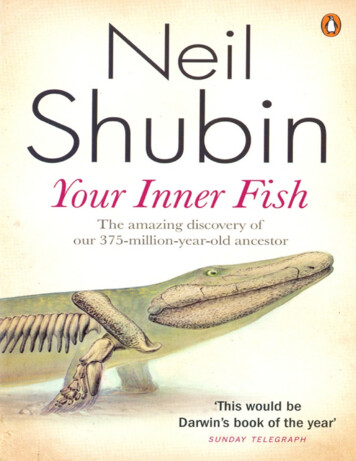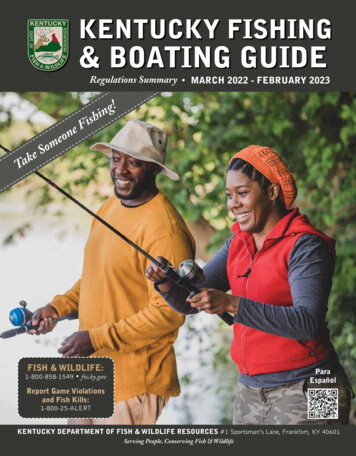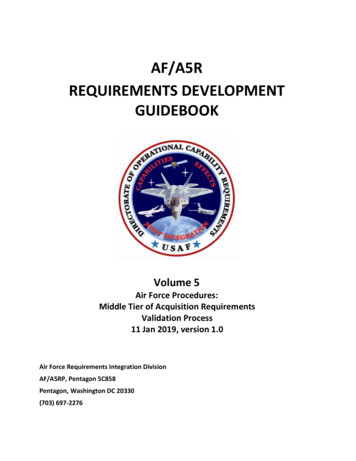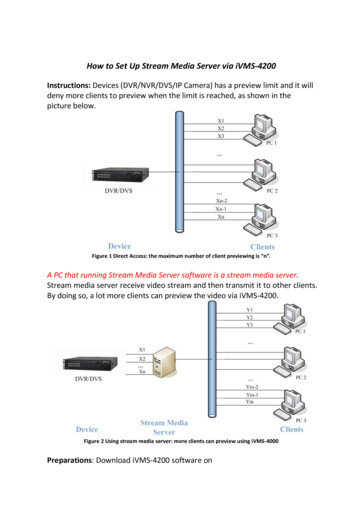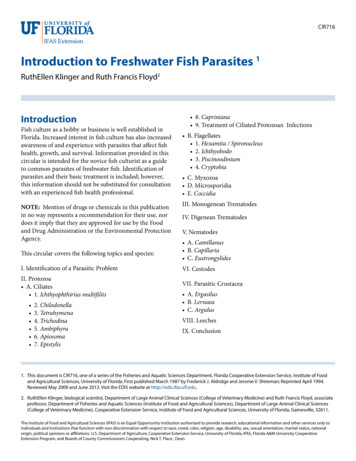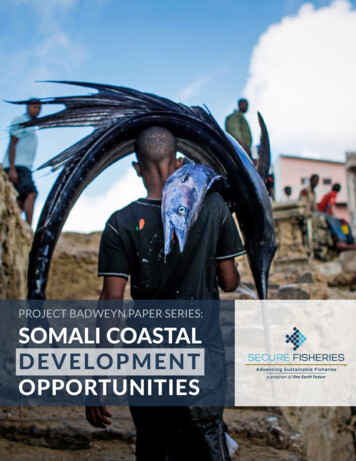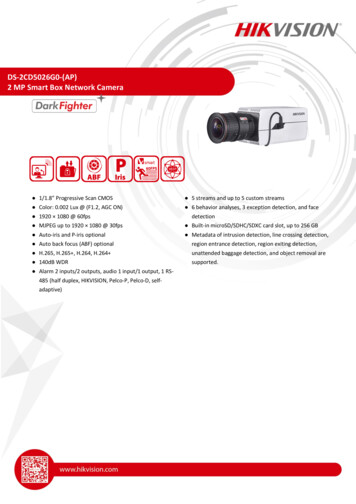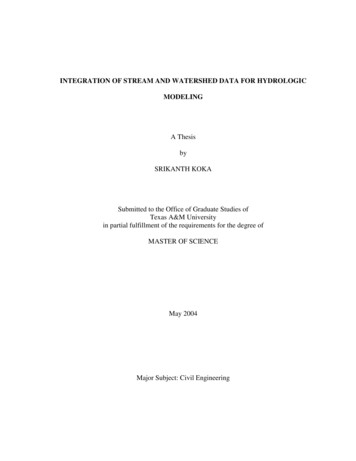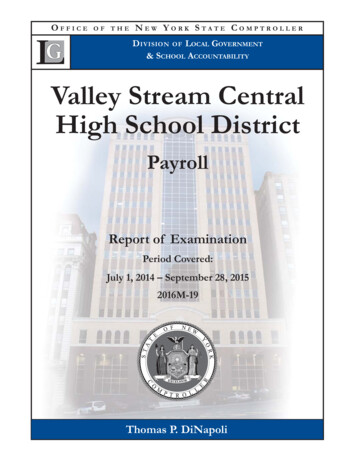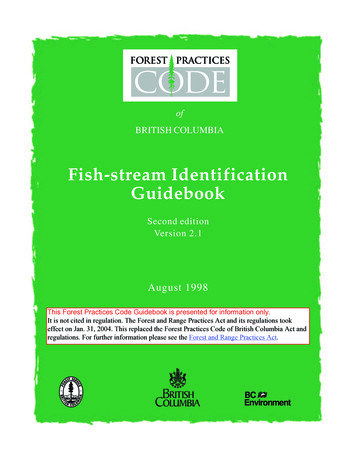
Transcription
ofBRITISH COLUMBIAFish-stream IdentificationGuidebookSecond editionVersion 2.1August 1998This Forest Practices Code Guidebook is presented for information only.It is not cited in regulation. The Forest and Range Practices Act and its regulations tookeffect on Jan. 31, 2004. This replaced the Forest Practices Code of British Columbia Act andregulations. For further information please see the Forest and Range Practices Act.BCEnvironment
Fish-stream Identification GuidebookofBRITISH COLUMBIAFish-stream IdentificationGuidebookSecond editionVersion 2.1August 1998AuthorityForest Practices Code of British Columbia ActOperational Planning Regulation
Canadian Cataloguing in Publication DataMain entry under title:Fish-stream identification guidebook. – 2nd ed.(Forest practices code of British Columbia)ISBN 0-7726-3664-81. Fishes – Habitat – British Columbia.2. Riversurveys – British Columbia. 3. Forest management –British Columbia. 4. Riparian forests – BritishColumbia – Management.I. British Columbia.Ministry of Forests.SH177.L63F58 1998634.9C98-960250-8
Fish-stream Identification GuidebookPrefaceThis guidebook has been prepared to help forest resource managers plan, prescribeand implement sound forest practices that comply with the Forest Practices Code.Guidebooks are one of the four components of the Forest Practices Code. Theothers are the Forest Practices Code of British Columbia Act, the regulations, andthe standards. The Forest Practices Code of British Columbia Act is thelegislative umbrella authorizing the Code’s other components. It enables the Code,establishes mandatory requirements for planning and forest practices, setsenforcement and penalty provisions, and specifies administrative arrangements.The regulations lay out the forest practices that apply province-wide. The chiefforester may establish standards, where required, to expand on a regulation.Both regulations and standards are mandatory requirements under the Code.Forest Practices Code guidebooks have been developed to support the regulations,however, only those portions of guidebooks cited in regulation are part of thelegislation. The recommendations in the guidebooks are not mandatoryrequirements, but once a recommended practice is included in a plan, prescriptionor contract, it becomes legally enforceable. Except where referenced by regulation,guidebooks are not intended to provide a legal interpretation of the Act orregulations. In general, they describe procedures, practices and results that areconsistent with the legislated requirements of the Code.The Fish-stream Identification Guidebook is referenced in the Operational PlanningRegulation (OPR) for (1) the definition of stream reach, (2) the methods acceptablefor determining stream channel gradient, and (3) the methods acceptable for fishinventories for the purpose of fish-stream identification. Therefore, stream reaches mustbe identified, stream channel gradients determined, and fish inventories performed inaccordance with the criteria and methods detailed in the following portions of thisguidebook:1.Part 1; page 4 provides the definition of reach for the purpose of the OPR.Supplementary information explaining the definition is in Part 1 pages 5 and 6.2.Part 2, subsection “Determination of stream gradient in the field” on pages 46 to48 provides the methods acceptable for the determination of channel gradientwithin a stream reach as referenced in paragraph (b) of the definition of fishstream. Boldface type at the head of this subsection indicates the reference to theOPR.3.Part 2, subsection “Fish sampling procedures,” page 51 identifies in bold-facetype the alternatives that satisfy the requirements for an acceptable fish inventoryas referenced in paragraph (b)(i) of the fish stream definition. The two options foriii
full field procedures for acceptable fish inventories are described in detail in“Acceptable survey methods” on pages 56 to 59. Boldface type at the head ofthis subsection indicates the reference to the OPR.A bar along the page margin labeled with the specific regulation as well asa change in text typeface identifies portions of Part 2 of this guidebookthat are referenced by regulation. Bold face type on page 33 of theChapter “Methods for identifying fish streams” also direct the reader tothe portions of Part 2 referenced by regulation.The information provided in each guidebook is intended to help users exercise theirprofessional judgement in developing site-specific management strategies andprescriptions designed to accommodate resource management objectives. Someguidebook recommendations provide a range of options or outcomes considered tobe acceptable under varying circumstances.Where ranges are not specified, flexibility in the application of guidebookrecommendations may be required, to adequately achieve land use and resourcemanagement objectives specified in higher-level plans. A recommended practice mayalso be modified when an alternative could provide better results for forest resourcestewardship. The examples provided in many guidebooks are not intended to bedefinitive and should not be interpreted as being the only acceptable options.
Fish-stream Identification GuidebookContentsPreface .iiiIntroduction .1Stream identification and classification objectives .2PART 1: DEFINITION OF REACH FOR PURPOSES OF THEOPERATIONAL PLANNING REGULATION (OPR 1*) .3Definition of reach for purposes of the Operational Planning Regulation .4PART 2: REQUIREMENTS AND RECOMMENDATIONS FOR FISH-STREAM IDENTIFICATIONAND STREAM CLASSIFICATION .7Stream-riparian classes .8Streams .Channel bed .Banks .Scour .Deposition .Alluvium .Non-classified drainages .Artificial channels .Stream reaches .Reach boundaries .Fish streams .88899101011111217Known barrier .18Fish species.19Direct tributary .20Factors influencing fish-stream identification.Stream reaches and fish inventories .2222Habitat use by fish .Gradients and stream fish distribution .Stream size, ephemeral streams and side channels .232325*OPR Operational Planning Regulationv
Fish-stream Identification GuidebookLakes and their tributaries .Natural barriers to fish distribution .Confirming fish absence upstream of known and potential barriers .Fisheries-sensitive zones .Estuaries (coastal streams only) and marine-sensitive zones .2626272831Methods for identifying fish streams .33Planning assessment and identification at the level of theforest development plan.34Fish-stream identification and stream-riparian classification at the level of thesilviculture prescription .Determination of the need for field surveys for fish-stream identification .Standards, permits and qualifications for fish-stream identification(OPR1; OPR1(b)(i)) .Field procedures .Determination of stream gradient in the field (OPR1) .Fish sampling procedures (OPR1(b)(i)) .Recommendations for maps and data records.Non-fish-bearing status report .Approach for review of non-fish bearing reaches .40444651596061References for fish-stream identification .633737Appendices1. Acquiring existing data .2. Example map for presentation of data for forest development plans andsilviculture prescriptions.3. Data forms for field surveys .4. Flowchart and checklist for fish-stream identification .64666770Figures1. Examples for identifying watercourses as streams for the purposes of the OPR(OPR1) .2. Illustration for section 2 paragraph (b) of the definition of reach for the purposesof the OPR (OPR1) .3. Riffle-bar-pool with gravel and wood – RPgw .4. Riffle-pool with cobbles and wood – RPcw .5. Debris-cobble-cascade-pool – CPcw .6. Boulder-cascade-pool – CPb .vi5613141414
Fish-stream Identification Guidebook7.8.9.10.11.Debris-boulder-step-pool – SPbw .Boulder-step-pool – SPb .Block-step-pool – SPr .“Large-channel” morphology .Example of a direct tributary to a known temperature-sensitive stream .1515151621vii
Fish-stream Identification GuidebookFish-stream Identification GuidebookIntroductionThe Forest Practices Code (Code) specifies planning and operational guidelines foreach phase of timber harvesting operations around streams, lakes and wetlands. Thisdocument, in conjunction with others such as the Riparian Management AreaGuidebook, provides managers, planners, and field personnel with suitable practicesto meet the objectives of the riparian management regulations of the Code. Onerequirement is to correctly identify streams on the basis of fish presence in order toensure the protection of fish populations and habitats during all phases of forestharvesting.Riparian management areas (RMAs) around streams consist of a riparian managementzone where some constraints to forest practices occur (e.g., basal area retention), andwhere required by the regulations, a reserve zone within which further constraints toforest practices are applied. The width of these zones is determined by the physicaland biological attributes of stream reaches and adjacent terrestrial ecosystems. Animportant attribute of streams is the presence of fish species. The proponent isresponsible for determining whether or not fish use a specific stream reach. The resultsof this determination form one component of the process for determining theappropriate RMA adjacent to that reach. To assist in fish-stream identification, theproponent can obtain existing fish inventory information and clarification of any of therequirements and procedures noted in this guidebook from the appropriate resourceagencies.Successful integrated management within watersheds for timber and aquatic resourcesdepends upon careful planning, training and clear communications between all stafflevels. Field information on fish populations in streams must be collected by properlytrained and experienced staff by using appropriate methods and level of effort, and atthe proper times of the year. This information should also be recorded and documentedby using consistent, standard formats. Information standards should be consistent withthose recommended by the federal-provincial Resources Inventory Committee (RIC)so that data may be collected, analyzed, stored and retrieved systematically. Thissystematic approach is essential to verify and support management decisions. Thesedata should be clearly incorporated into operational plans. All staff includingengineering, forestry, supervisory and field personnel must discuss these plans andensure that all are aware of their roles in meeting the objectives of the plans. Mapsshowing fish-bearing streams, stream-riparian classes, and areas of environmentalsensitivity should be provided to all supervisory staff and field crews.The proponent is required to use the best available information for the identification,classification and mapping of streams for forest development plans. Known informationwill be made available to the proponent by government agencies (BC Ministry ofEnvironment, Lands and Parks [MELP] and BC Ministry of Fisheries [BCF]). Theidentification, classification and mapping of all streams for site-level operational plans,1
Fish-stream Identification GuidebookFish-stream Identification Guidebookwhich include the silviculture prescription and road layout and design, is fully theresponsibility of the proponent. The choice of appropriate procedures in each specificinstance is also the responsibility of the proponent. This guidebook provides and refersto standard approaches and methodologies that should seriously be considered by theproponent, and will be used by resource agencies for assessment and audit of streamriparian classifications, management and mapping. Use of known information on fishdistribution contained within the provincial reconnaissance fish and fish habitatinventory will greatly assist the proponent in evaluating the likelihood of fishoccurrence, and the need for field surveys for fish-stream identification for areas wherethis information has been collected. This will minimize the extent and cost of detailedsurveys for fish-stream identification.This document applies to the entire province. Cases where a guideline appliesspecifically to either the coastal or interior areas of BC are indicated.Stream identification and classification objectivesAn important step in determining the appropriate Code riparian prescriptions is tocorrectly identify fish bearing streams and those without fish. Consistent with theobjectives for RMAs, correct classification of streams is critical for minimizing theeffects of land use practices on stream channels and aquatic ecosystems including fishpopulations, their habitats, and water quality. Although minor effects on aquatic andriparian ecosystems are difficult to avoid completely, application of the presentguidelines will minimize the harmful effects of forest harvesting upon them.This guidebook consists of two parts. Part 1 contains the definition of reach for thepurposes of the Operational Planning Regulation (OPR). Streams are defined onthe basis of the reach. Part 2 contains the procedural requirements andrecommendations for identifying fish streams, measuring stream channel width andgradient within stream reaches, and applying the appropriate stream class for eachreach.2
Fish-stream Identification GuidebookFish-stream Identification GuidebookPART 1DEFINITION OF REACH FOR PURPOSES OF THEOPERATIONAL PLANNING REGULATION3
Fish-stream Identification GuidebookFish-stream Identification GuidebookDefinition of reach for purposes of theOperational Planning Regulation1The definition of reach in this Part does not apply to the rest of the guidebook except whenused within the definition of stream.2For the purposes of the definition of “reach” in section 1 of the Operational PlanningRegulation, B.C. Reg. 105/98,OperationalPlanningRegulationSection 1“reach” means a watercourse that has a continuous channel bed that meets one of thefollowing requirements:(a)the channel bed is at least 100 m in length, measured from any of the followinglocations to the next of any of the following locations:(i)the location where the watercourse begins or ceases to have a continuouschannel bed;(ii)the location where(A) a significant change in morphology occurs, for example at the junction of amajor tributary, and(B) the mean width of the channel bed, as measured over a representative100 m length of channel bed, upstream and downstream of themorphological change is sufficient to change the riparian class of thewatercourse, if the watercourse were a stream;(iii) the location where(A) a significant change in morphology occurs, for example at the junction of amajor tributary, and(B) the mean gradient of the channel bed, as measured over a representative100 m length of channel bed upstream and downstream the morphologicalchange, changes from less than 20% to 20% or more, or vice versa;(b)the channel bed is at least 100 m in length, made up of one or more segments, theboundaries of which are any of the locations referred to in paragraph (a);(c)the channel bed is less than 100 m in length, if the continuous channel bed(i)is known to contain fish,(ii)flows directly into a fish stream or a lake that is known to contain fish, or(iii) flows directly into a domestic water intake.4
Fish-stream Identification GuidebookFish-stream Identification GuidebookOperationalPlanningRegulationSection 1continuedFigure 1.Examples for identifying watercourses as streams for the purposes of the OPR. For eachexample, assume that the continuous channel bed also satisfies the criterion of scour or alluvialdeposition as required in the definition of stream in the OPR.A. Watercourse with a continuous channel bed 100 m long, not known to contain fish,and flows into a swamp is not a stream [see 2(a)].B. Watercourse with a continuous channel bed 100 m long and flows into a swamp isa stream [see 2(a)].C. Watercourse with a continuous channel bed 100 m long and flows into a non-fishstream is a stream [see 2(a)].D. Watercourse with a continuous channel bed 100 m long and flows directly into anon-fish stream is not a stream [see 2(a)].E. Watercourse with a continuous channel bed 100 m long and known to contain fishis a stream [see 2(c)(i)].F. Watercourse with a continuous channel bed 100 m long, and flows directly into anassessed and classified (S4) fish stream (G) is a stream [see 2(c)(ii)].5
Fish-stream Identification GuidebookFish-stream Identification GuidebookOperationalPlanningRegulationSection 1continuedIn this example, a tributary with two falls discharges into a non-fish stream. Thetwo falls divide the tributary into three channel segments each 60 m long.Although each segment is 100 m long, the segments are connectedsequentially, and the channel bed is continuous for the entire 180 m total length.Therefore, the entire tributary length shown meets the definition of reach andtherefore is a stream.Gradient should be determined as a mean for the entire 180 m length of the threesequential segments. If the mean gradient is 20%, the 180m reach is a defaultfish stream.Figure 2.6Illustration for section 2 paragraph (b) of the definition of reach for the purposes of the OPR.
Fish-stream Identification GuidebookFish-stream Identification GuidebookPART 2REQUIREMENTS AND RECOMMENDATIONSFISH-STREAM IDENTIFICATION ANDSTREAM CLASSIFICATIONFOR7
Fish-stream Identification GuidebookFish-stream Identification GuidebookStream-riparian classesStreamsThe Code defines a stream as a reach, flowing on a perennial or seasonal basis havinga continuous channel bed, whether or not the bed or banks of the reach are locallyobscured by overhanging or bridging vegetation or soil mats, if the channel bed:1.is scoured by water, or2.contains observable deposits of mineral alluvium.The primary feature for determining whether a watercourse is a stream under the Codeis the presence of a continuous channel bed. If a continuous channel bed exists, theneither one of two other key features must be present demonstrating fluvial processes;that is, where flowing water has:1.scoured the channel bed, or2.deposited any amount of mineral alluvium within the channel.Water flow in the channel may be perennial, ephemeral (seasonal), or intermittent(spatially discontinuous).Channel bedThe channel constitutes the linear “vessel,” boundary or lining within which water,sediment and debris move downstream. The floor of the channel is commonly termedthe bed, and the walls are the banks. Channels are incised into the terrain to variousdegrees due to the process of fluvial erosion. The channel must be continuous in orderfor water, sediment and debris to be transferred downstream. The boundary can beeither alluvial (water-borne material) or non-alluvial (geological materials not depositedby streamflow and include bedrock, morainal tills and coarse colluvium). The channelbed (i.e., the stream) ceases to exist, that is, is discontinuous where flow seeps into theground.BanksMost streams also have definable, visibly continuous banks. However, the banks ofsome smaller streams may be discontinuous. In these cases, the banks and channel bedof short segments of stream may not be visible due to the presence of bridging oroverhanging vegetation, or the stream has scoured a channel underneath rooted mats ofsoil. In other cases, segments of the channel might be filled to the crest of the bankswith colluvial deposits as a result of debris jams. However, in all cases, the channelshould be detectable throughout the length of the stream being defined such that flowwill also be continuous.8
Fish-stream Identification GuidebookFish-stream Identification GuidebookSome streams have multiple channels each with definable banks. In this case, thevegetated terrestrial area between the channels is not considered part of the streamwhen channel widths are measured as one part of the determination of stream-riparianclass.ScourScour should be sufficient to erode at least some portion of the channel bed down tothe mineral substrate which might include soil and (or) bedrock. This erosiondemonstrates that the watercourse has sufficient power to move materials downstream.Low gradient channels might have beds consisting primarily of finer materials such assand or small gravel. In steep channels with more erosive power, high rates of scoursometimes result in channel beds consisting predominantly of bedrock, cobbles orboulders. In extreme cases, channels may be almost completely scoured of sedimentsuch that only a few large cobbles or boulders remain in the streambed. The spectrumof channels ranging from low power watercourses with observable deposits of sand tochannels demonstrating extreme degrees of scour are included within the definition ofstream.Evidence of scour should be more extensive than that shown at a small, isolated plungepool, or by an isolated boulder or cobble. Scour might be observed to be either:1.continuous along the entire reach,2.intermittent along the reach and interrupted by areas of alluvial deposition, or3.intermittently visible along a continuous channel bed that has been clearlyformed by flowing water but has had some of its scoured (and depositional)portions locally overlain by a thin, seasonal cover of organic materials (these maybe present, for example, from summer leaf fall and have accumulated because oflow stream power in the autumn).DepositionVisible deposits of water-borne, mineral sediment might also be observed to beeither:1.continuous along the entire channel bed,2.intermittent along the channel bed and interrupted by areas where the channel isscoured, or3.intermittently visible along a continuous channel bed that has been clearlyformed by flowing water but has had some of its sediment deposits (and scouredportions) locally overlain by a thin, seasonal cover of organic materials (these maybe present, for example, from summer leaf fall and have accumulated because oflow stream power in the autumn).9
Fish-stream Identification GuidebookFish-stream Identification GuidebookAlluviumAlluvium includes all mineral (clastic) particles deposited by flowing water. Theseparticles range in size from sands (i.e., 0.25–2 mm diameter) to gravels, cobbles andboulders. Silts (particles 0.25 mm diameter) are included as alluvium only whenlacustrine or marine deposits form the only available mineral substrate within awatershed.Small watercourses with organic beds but no observable deposits of mineral alluvium,or no scour in their beds down to mineral soil, are not included under the definition ofstream. Watercourses with organic beds may:1.consist of accumulated detrital materials such as decomposed and (or) wholeleaves, roots, twigs and moss2.contain mixed silt/organic mud deposits which may be covered in livinghydrophytic vegetation (e.g., brown moss, Sphagnum).These watercourses, particularly common in the northern interior, are frequently foundat the head of drainages in areas of low topographic relief, or in other sites where slopegradient is nearly zero. Flow in these channels is usually seasonal. The potential forscour is consequently low and is confirmed by the presence of an organic bed. Thesechannels sometimes emerge immediately downslope from groundwater seeps. Seepagesites and other areas where unchanneled surface water occurs due to a seasonallyelevated water table are also not streams.Regions of minimal topographic relief such the Taiga Plains, the northeastern portion ofthe Queen Charlottes, and elsewhere in both coastal and interior drainages, containslow-flowing watercourses that may be in the vicinity of wetlands and wetlandcomplexes. Often, these channels are relatively large ( 1.5 m wide) but smallerwatercourses may be included within this category. The channel beds of thesewatercourses are carved down into deep accumulations of peat, and mineral soil ispresent only at some greater depth. Alternatively, the only mineral material available aresilts from lacustrine or marine deposits. Despite these features, watercourses withcontinuous channel beds are included within the definition of stream. They areaccessible to fish in many cases, and therefore, are often fish streams.Non-classified drainagesWatercourses which do not satisfy the definition of reach provided in Part 1 of thisguidebook, and therefore, do not meet the criteria for the definition of stream in section1 of the Operational Planning Regulation, are to be designated as non-classifieddrainages (NCDs).10
Fish-stream Identification GuidebookFish-stream Identification GuidebookArtificial channelsThe great majority of streams which will be encountered in forestry operations willhave been formed naturally. Artificial channels, most often with ephemeral flow, whicharise as a consequence of forestry activities such as road-building (ditches), recentyarding (tracks along hillslopes that channel rainwater runoff ), are not streams.Artificial channels constructed to enhance fisheries (e.g., salmon spawning and rearingchannels) should also be managed as fish-bearing streams. There also are channelsconstructed historically as drainage ditches, often located within or near agriculturallands, that have become known fish habitats. These artificial drainages may containimportant populations of fish and are managed for their fish resources. Consult with theBC Ministry of Forests (MOF), BC Ministry of Environment, Lands and Parks(MELP), BC Ministry of Fisheries (BCF), and Department of Fisheries and Oceans(DFO) to confirm the value of these artificial channels.Stream reachesThe basic unit employed to determine whether a watercourse is a stream and to assignthe correct stream-riparian class is the stream reach. Streams may consist of a singlereach, but more commonly are composed of a sequence of different reaches exte
This Forest Practices Code Guidebook is presented for information only. It is not cited in regulation. The Forest and Range Practices Act and its regulations took effect on Jan. 31, 2004. This replaced the Forest Practices Code of British Columbia Act an . The proponent is required to use the best available information for the identification,
